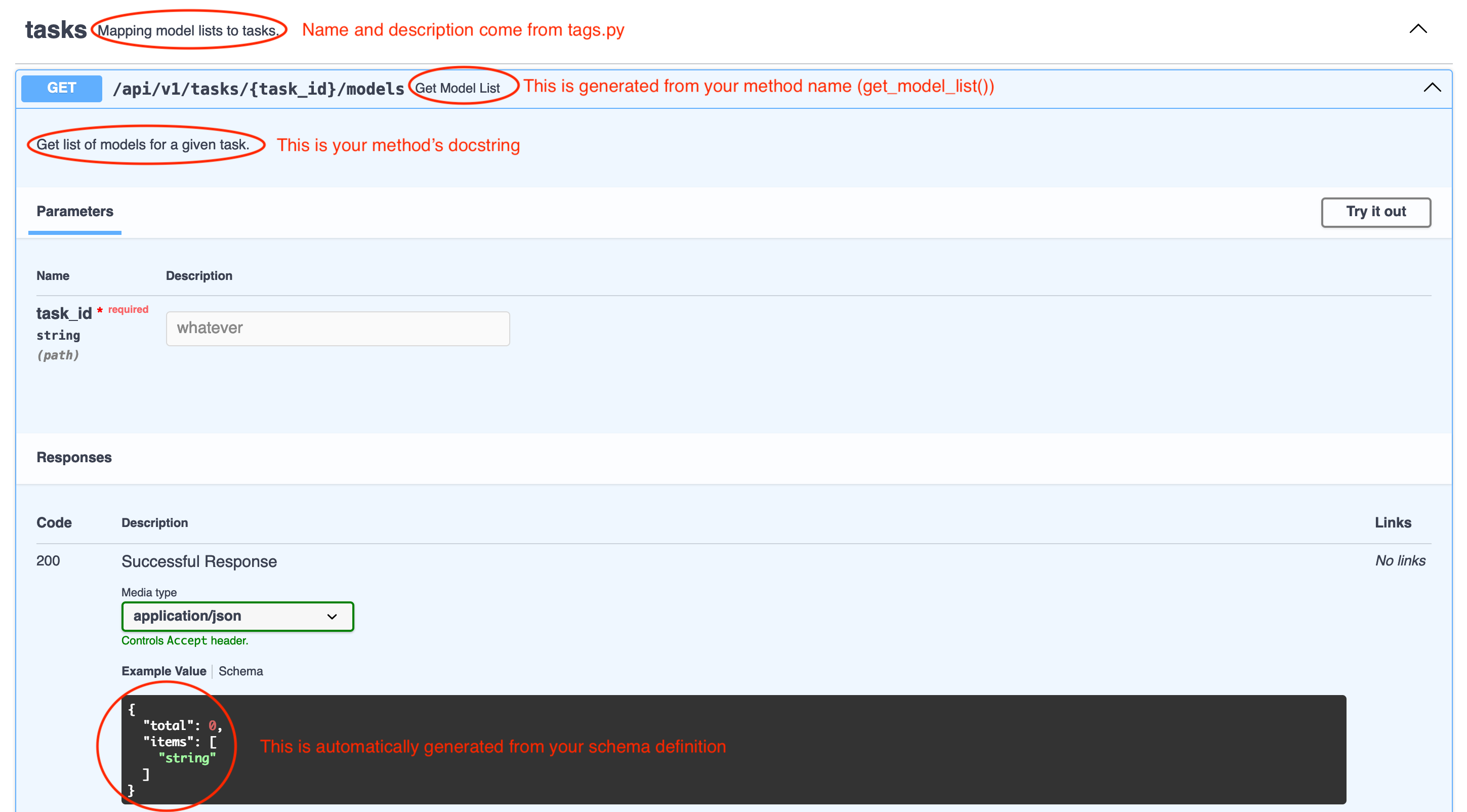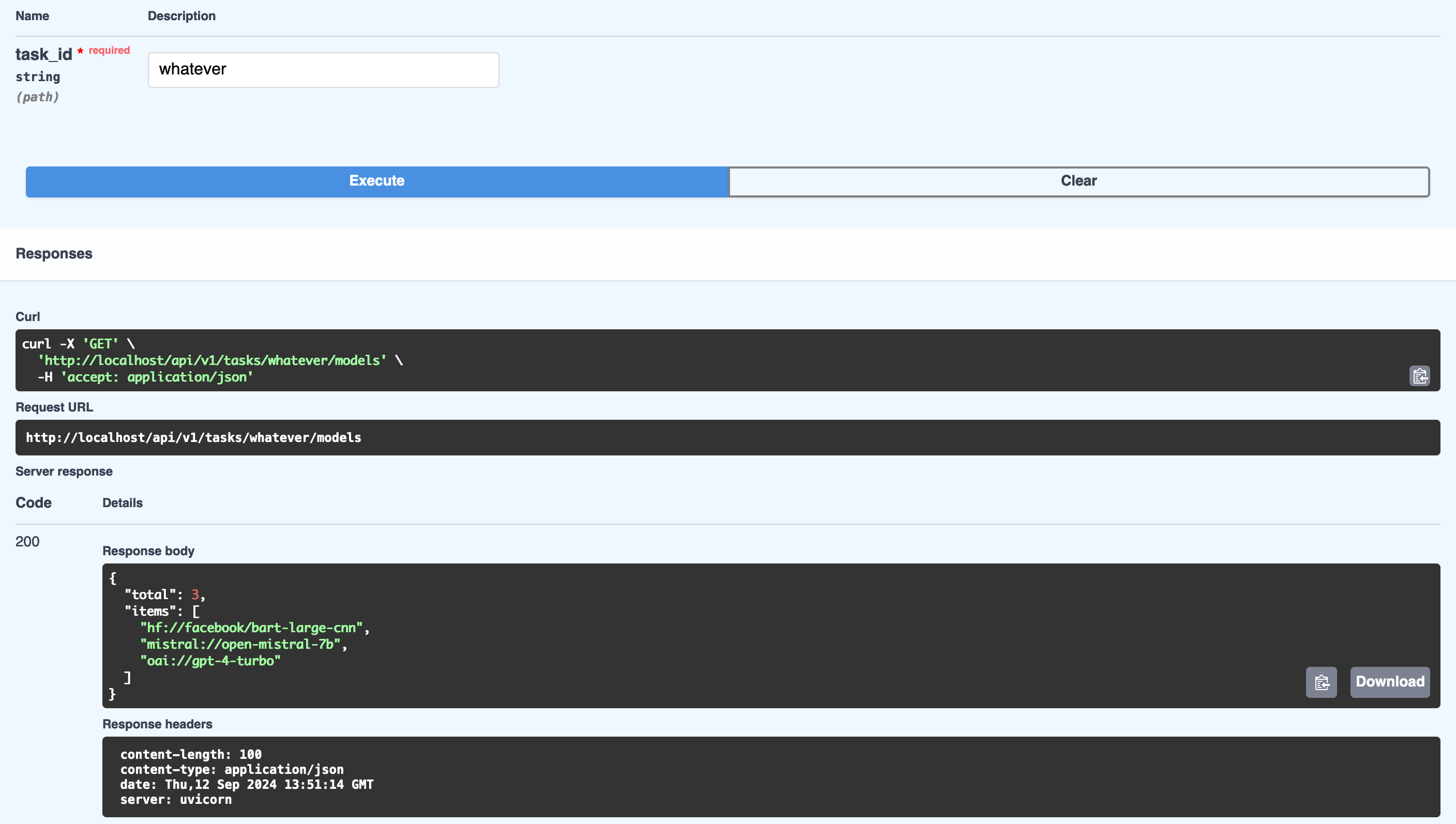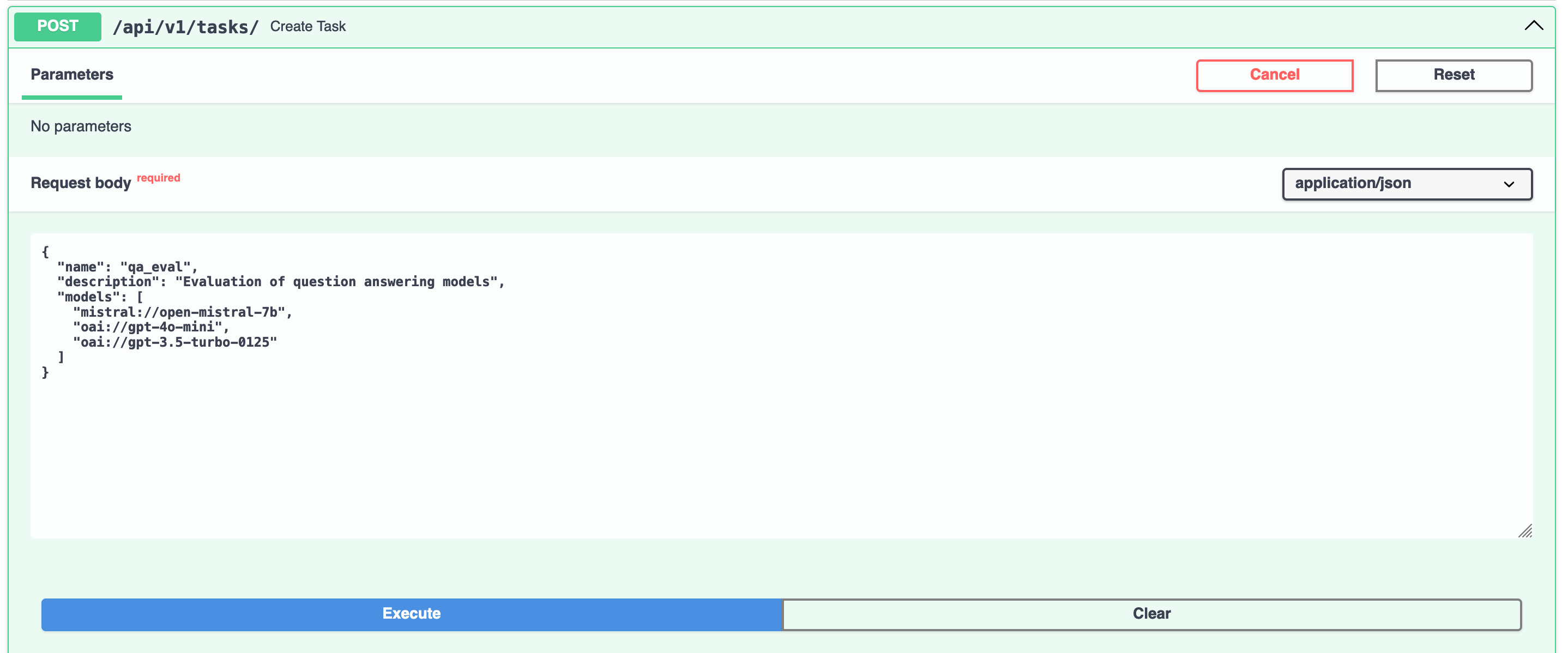Creating a new endpoint
The examples in the Understanding Lumigator Endpoints guide show the main pieces of code involved in writing a new endpoint. Let us take a toy example, which is creating an endpoint which given a task in the form of a string (e.g. “summarization”) will return a list of model names (string URIs) to be evaluated for that task. As you do not have a table with this information in our database yet, you will also create a method to actually store this list in a table.
Step 1: Create a static endpoint
As a first step, you’ll create a static endpoint which, regardless of the input, will always return the same list of models. This is a good way to start as it allows you to wire the endpoint, see it in the docs, and make sure its schema is correct, without the need to access the database yet.
1.1. Write the router code
The following code implements a barebone version of our endpoint, one which does not require any
connection to the DB nor a specific schema definition. It defines one method get_model_list that
always returns a ListingResponse[str] object, basically a dictionary containing a list of items
of a predefined type (strings in our case) and a total field with the number of items. Note that
task_id is not even used, but this will change as soon as we want to get a list which is
task-specific.
from fastapi import APIRouter
from schemas.extras import ListingResponse
router = APIRouter()
@router.get("/{task_id}/models")
def get_model_list(task_id: str) -> ListingResponse[str]:
"""Get list of models for a given task."""
return_data = {
"total": 3,
"items": [
"hf://facebook/bart-large-cnn",
"mistral://open-mistral-7b",
"oai://gpt-4-turbo",
],
}
return ListingResponse[str].model_validate(return_data)
Being this the code for a new route, you will save it in backend/api/routes/tasks.py.
1.3. Test
If you’re running Lumigator locally, connect to http://localhost:8000/docs
and you should see the following:

If you click on Try it out, add any value for task_id and then click on Execute you should get
the following response:

Step 2: Wire the endpoint to the DB
You have a new running endpoint! Too bad it always return the same identical data… Let’s fix this by connecting it to the database.
2.2. Define schema
To have a more useful endpoint, let us first update the schema with a few additional fields. The
following goes intoschemas/tasks.py:
import datetime
from uuid import UUID
from pydantic import BaseModel
class TaskCreate(BaseModel):
name: str
description: str = ""
models: list[str]
class TaskResponse(BaseModel, from_attributes=True):
id: UUID
name: str
description: str
created_at: datetime.datetime
models: list[str]
If you look at TaskResponse, you can see that we added an id to uniquely identify the task, a
name that we can show e.g. in a list for users to choose from and a description. The field
created_at will be automatically filled when creating a new record. The list of models still
appears, but we removed the count as we’ll likely provide short lists and we can expect to be able
to get their length programmatically.
The TaskCreate class, instead, will be used to define the input to the create_task method in the
API (the fields id and created_at are not necessary, as they’ll be created automatically by the
database).
2.2. Define repositories and records
The code for a new repository (to be stored in backend/repositories/tasks.py) is quite standard:
from sqlalchemy.orm import Session
from backend.records.tasks import TaskRecord
from backend.repositories.base import BaseRepository
class TaskRepository(BaseRepository[TaskRecord]):
def __init__(self, session: Session):
super().__init__(TaskRecord, session)
This does not usually change much as long as you are fine with the base methods provided by the
BaseRepository
class.
The TaskRepository is a repository that allows to run the set of methods defined in the
BaseRepository on the table defined by TaskRecord. You can define a TaskRecord in
backend/records/tasks.py as follows:
from sqlalchemy.orm import Mapped, mapped_column
from backend.records.base import BaseRecord
from backend.records.mixins import CreatedAtMixin, NameDescriptionMixin
class TaskRecord(BaseRecord, NameDescriptionMixin, CreatedAtMixin):
__tablename__ = "tasks"
models: Mapped[list[str]] = mapped_column(nullable=False)
Similarly to what you saw before for DatasetRecord, TaskRecord inherits from
BaseRecord
the property of having an id primary key. In addition to that, it inherits name and
description from NameDescriptionMixin and created_at from CreatedAtMixin. The only field
that we need to specify manually is models, a non-null column holding a list of strings.
As SQLAlchemy does not have a built-in mapping from list[str], you also need to update
BaseRecord to provide one explicitly by changing the following:
type_annotation_map = {dict[str, Any]}
to
type_annotation_map = {dict[str, Any]: JSON, list[str]: JSON}
2.3. Save DB-accessing methods into a TasksService
Now that you have an abstraction for the tasks table, you can use it to implement the different
methods needed to manage tasks. You’ll do it inside backend/services/tasks.py:
from uuid import UUID
from fastapi import HTTPException, status
from backend.records.tasks import TaskRecord
from backend.repositories.tasks import TaskRepository
from schemas.extras import ListingResponse
from schemas.tasks import TaskCreate, TaskResponse
class TaskService:
def __init__(self, tasks_repo: TaskRepository):
self.tasks_repo = tasks_repo
def _raise_not_found(self, task_id: UUID) -> None:
raise HTTPException(status.HTTP_404_NOT_FOUND, f"Task '{task_id}' not found.")
def _get_task_record(self, task_id: UUID) -> TaskRecord:
record = self.tasks_repo.get(task_id)
if record is None:
self._raise_not_found(task_id)
return record
def get_task(self, task_id: UUID) -> TaskResponse:
record = self._get_task_record(task_id)
return TaskResponse.model_validate(record)
def create_task(self, request: TaskCreate) -> TaskResponse:
# Create DB record
record = self.tasks_repo.create(
name=request.name, description=request.description, models=request.models
)
return TaskResponse.model_validate(record)
def delete_task(self, task_id: UUID) -> None:
record = self._get_task_record(task_id)
# Delete DB record
self.tasks_repo.delete(record.id)
def list_tasks(self, skip: int = 0, limit: int = 100) -> ListingResponse[TaskResponse]:
total = self.tasks_repo.count()
records = self.tasks_repo.list(skip, limit)
return ListingResponse(
total=total,
items=[TaskResponse.model_validate(x) for x in records],
)
The main methods implemented here are:
create_task: uses thecreatemethod in the task repository (a method inherited byBaseRepository) to save a new task record. Therequestinput parameter is defined in theTaskCreateschema and the output is aTaskResponse.delete_task: given a taskUUID, deletes the corresponding record from the table. Note that, as all the other methods that rely on_get_task_record, an HTTP 404 exception is thrown if a matching record is not found in the table.get_task: given a taskUUID, return the corresponding record (as aTaskResponse)list_tasks: returns aListingResponseofTaskResponseelements (i.e. a list of tasks stored in the table).
Note how similar this is to some of the other services (e.g. DatasetService): you can expect this
from services which only deal with the DB as the main operations you’ll do are those who operate on
a table (create, delete, get, list, etc). You will likely see a different behavior in more advanced
endpoints (e.g. those which involve running ray jobs), but we’ll discuss that in another tutorial.
2.4. Inject dependencies into a TaskService
As TaskService depends on the existence of a database, we should inject a dependency on a DB session.
To do this, add the following code to
backend/api/deps.py:
def get_task_service(session: DBSessionDep) -> TaskService:
task_repo = TaskRepository(session)
return TaskService(task_repo)
TaskServiceDep = Annotated[TaskService, Depends(get_task_service)]
2.5. Update routes
You are almost there! The last thing you need to do is update the backend/api/routes/tasks.pyfile
with new code which will map API requests to TaskService methods:
from uuid import UUID
from fastapi import APIRouter, status
from backend.api.deps import TaskServiceDep
from schemas.extras import ListingResponse
from schemas.tasks import TaskCreate, TaskResponse
router = APIRouter()
@router.post("/", status_code=status.HTTP_201_CREATED)
def create_task(service: TaskServiceDep, request: TaskCreate) -> TaskResponse:
return service.create_task(request)
@router.get("/{task_id}")
def get_task(service: TaskServiceDep, task_id: UUID) -> TaskResponse:
return service.get_task(task_id)
@router.delete("/{task_id}", status_code=status.HTTP_204_NO_CONTENT)
def delete_task(service: TaskServiceDep, task_id: UUID) -> None:
service.delete_task(task_id)
@router.get("/")
def list_tasks(
service: TaskServiceDep,
skip: int = 0,
limit: int = 100,
) -> ListingResponse[TaskResponse]:
return service.list_tasks(skip, limit)
2.6. Test
To test your new endpoint, connect to http://localhost:8000/docs. You should see a new section like the following one:

Here is an example for the creation of a new task:

And here is the format of a task list (to which we have also added a summarization_eval task):

Final checks and reference code
Creating a new endpoint in Lumigator requires some prior knowledge about the system and due to how the code is structured you will have to edit many different files (see the picture below). Once you get the gist of it, though, the task can be quite straightforward (albeit a bit repetitive), especially if the endpoint mostly has to deal with database operations.